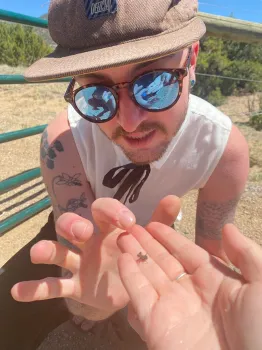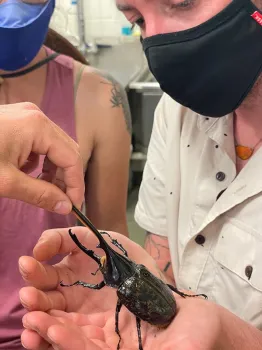
Zemenick, who began work July 1, first traveled to Sagehen while in graduate school and conducted dissertation research there on how plant visitors shape floral microbial communities.
What sparked Ash's interest in entomology? "I first became interested in entomology as an undergraduate student at the University of Michigan. I learned how important insects are in agroecosystems, and how their intricate, overlapping interactions can have strong impacts on sustainable management and crop production."
As a youngster, "I was kind of afraid of bugs--at least when they were in the house--but once I started learning about them I was so fascinated. This was solidified when I took Bug Boot Camp (the Insect Taxonomy and Field Ecology" course taught at the Sagehen Field Station by ant specialist Phil Ward, professor of entomology, UC Davis Department of Entomology and Nematology) where I fell in love with parasitoid wasps."
Zemenick, a native of Grosse Pointe Woods, Mich., received a doctorate in ecology from UC Davis in September 2017, studying with Jay Rosenheim, distinguished professor of entomology, and with assistant professor Rachel Vannette, a Hellman fellow.
And now, in a near full-circle move, Zemenick is back home.

The Sagehen Field Station, headquartered in Truckee on a 9000-acre site on the western slope of the Sierra Nevada, has focused on research and teaching since 1951. It serves as the hub of a broader network of research areas known as the Central Sierra Field Research Stations, comprised of not only the Sagehen Creek Field Station, but Central Sierra Snow Laboratory, Onion Creek Experimental Watershed, Chickering American River Reserve, and North Fork Association Lands, according to the website.
The surrounding watershed is also available to researchers and classes through an agreement with the Forest Service and includes extensive stands of yellow pine, mixed conifer, and red fir forests, as well as sagebrush fields, scattered mountain meadows, and fens (marshland).
More than 80 graduate students--including Zemenick--have worked on their projects at Sagehen, completing their degrees on such topics as behavioral studies of dark-eyed juncos, stream runoff modeling, bees/butterflies in mountain montane meadows, and GIS as a tool for reserve master planning.
In addition to managing the Sagehen Creek Field Station, Zemenick will coordinate requests to work at Chickering American River Reserve as well as North Fork Association Lands. As Chickering and the North Fork lands are privately owned, user visits are negotiated with the private land partners.
Zemenick returns to California after serving as a National Science Foundation postdoctoral fellow in the Weber lab at Michigan State University. "I studied how plant-mite interactions directly and indirectly influence leaf microbial communities and subsequent invasibility by pathogens."
"I co-created, built and directed Project Biodiversify, an online repository of teaching tools to promote diversity, inclusion and belonging in STEM classrooms," said Zemenick. The federally funded Michigan State University project "includes how biological research applies to current societal problems and highlighted what it is like to be a biologist. The materials are comprised of examples provided by biologists that self-identify as being part of underrepresented group(s) in STEM (e.g. in terms of race, ethnicity, gender, sex, sexuality, income, nationality, immigrant status, cognitive and physical ability, etc.)." The project was recently awarded a University Level Excellence in Diversity Award for work promoting diversity, equity and inclusion (DEI) in biology education.
Zemenick will continue pursuing ecology and environmental science involving plants, insects, microbes, ecological networks, natural history, and discipline-based education research. Leisure time includes such interests as naturalizing, backpacking, climbing and biking. "I hiked the Nüümü Poyo (John Muir) Trail in 2009 and love the mountains," the ecologist related.
(Editor's Note: Science writer Kathleen Wong of the UC Natural Reserve System contributed to this story.)

